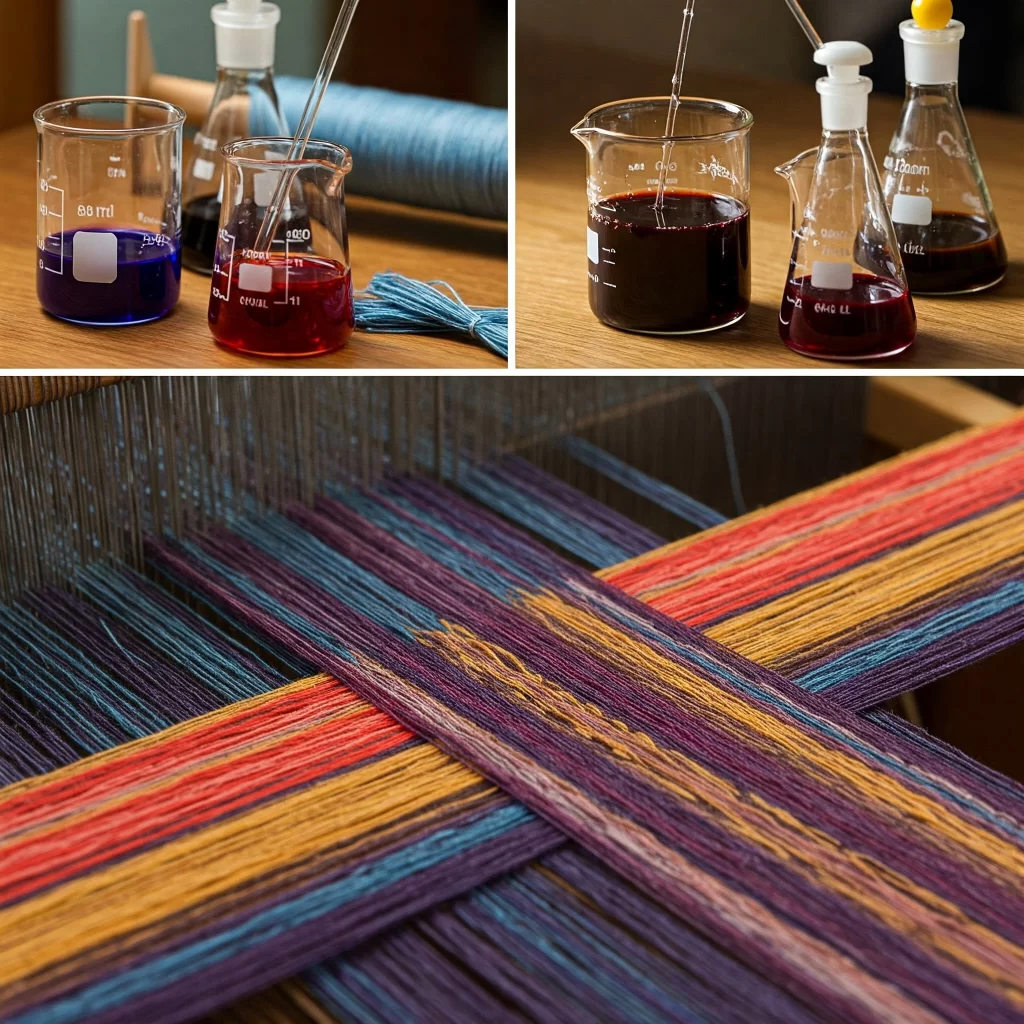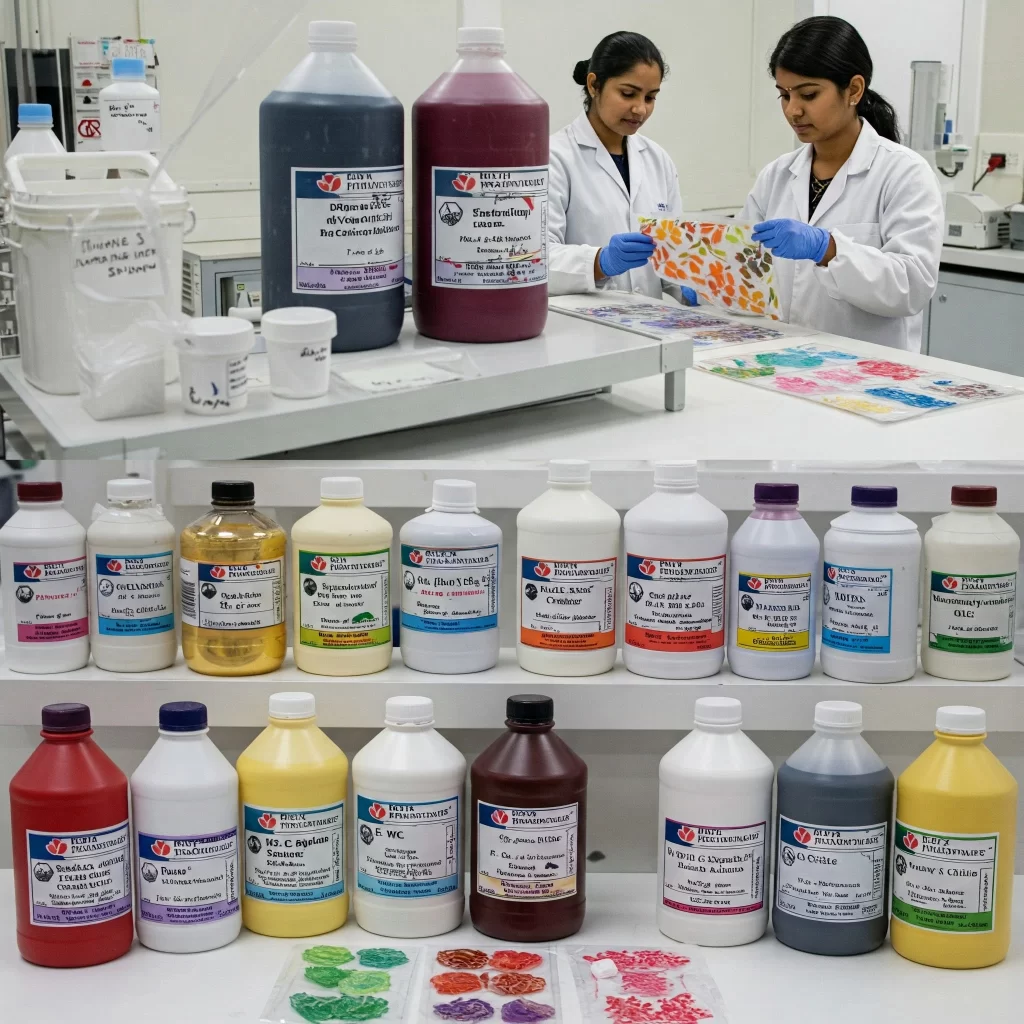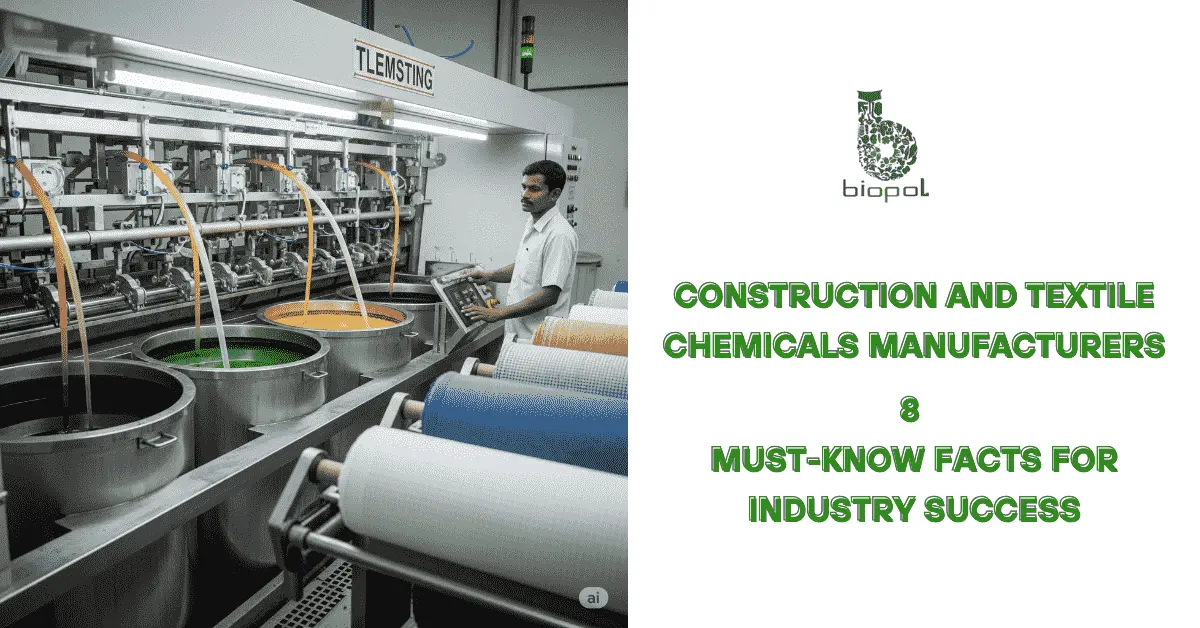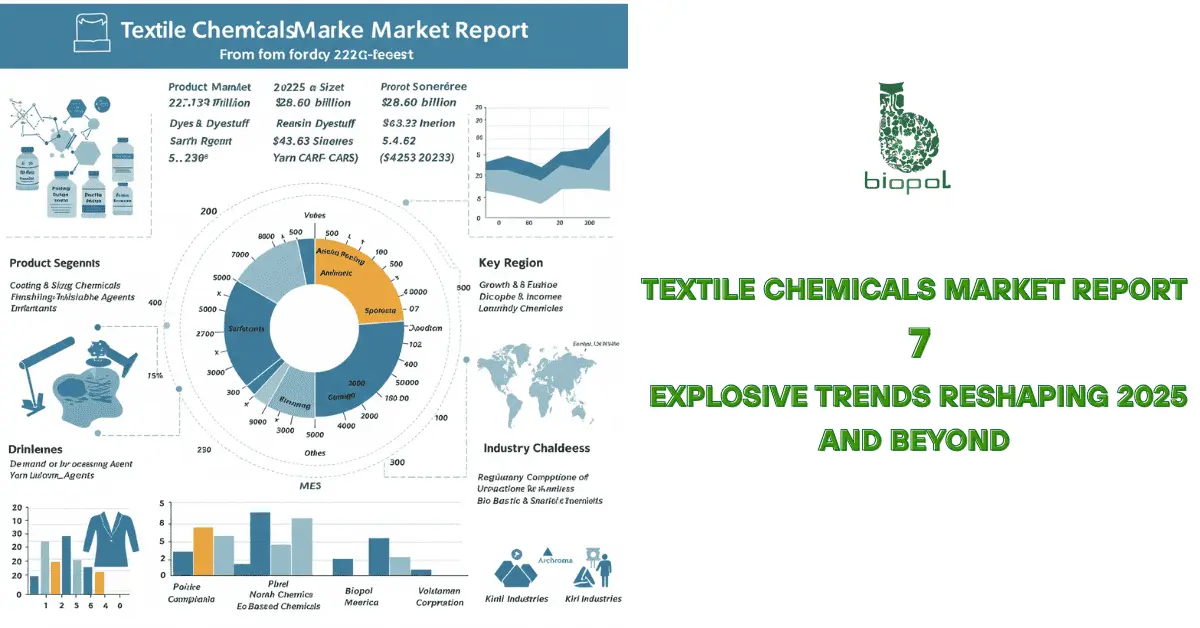
Textile chemicals and auxiliaries form the lifeblood of modern textile processing. Textile chemicals and auxiliaries, frequently unnoticed in the completed apparel, are crucial at every step of manufacture. From preparing raw fibers to imparting the desired color, finish, and performance properties, they are indispensable. Think about it – how else would we achieve that vibrant hue or the soft touch of our favorite fabrics?
Table of Contents
Types and Applications of Textile Chemicals and Auxiliaries
The domain of textile processing involves a diverse array of chemical substances, each playing a crucial role in transforming raw materials into finished fabrics. These chemicals can be broadly categorized into four primary groups:
Pretreatment Agents
These chemicals prepare the textile fibers for subsequent processing steps, such as dyeing and finishing. Key examples include:
Scouring agents: Remove natural impurities like waxes and oils from fibers.
Bleaching agents: Whiten fabrics by removing natural pigments.
Desizing agents: Eliminate sizing agents applied to yarns during weaving.
Dyeing Auxiliaries
These chemicals facilitate the even and efficient absorption of dyes onto fibers. They include:
Leveling agents: Ensure uniform color distribution.
Dispersing agents: Prevent dye particles from clumping, especially for synthetic fibers.
Retarding agents: Control the rate of dye absorption.
Finishing Chemicals
These chemicals impart desired properties like softness, water repellency, and wrinkle resistance to the fabric. Examples include:
Softeners: Improve fabric hand feel.
Water repellents: Create a barrier against moisture.
Flame retardants: Reduce flammability.
Performance Enhancers
These chemicals provide additional functionalities to textiles, such as:
Antimicrobial agents: They serve to suppress the growth of both bacteria and fungi.
UV protectants: Shield fabrics from harmful UV radiation.
Anti-static agents: Reduce static cling.
The judicious selection and application of these textile chemicals are paramount to achieving high-quality, functional, and sustainable textile products.
Enhancing Fabric Performance
The diverse functionalities exhibited by contemporary textiles are significantly attributable to the application of specialized textile chemicals and auxiliaries during processing. These substances play a critical role in modifying the inherent properties of textile fibers, thereby imparting enhanced characteristics suitable for a wide array of end uses.
The impact of textile chemicals and auxiliaries on fabric performance can be summarized as follows:
| Aspect | Details |
| Tactile Properties | Specific finishing auxiliaries reduce inter-fiber friction. This lubrication effect at the microscopic level results in a markedly improved and softer hand feel. |
| Durability | Certain chemical treatments augment the structural integrity of the fibers. This leads to increased resistance against abrasion, tensile stress, and other forms of mechanical degradation. Consequently, the service life of the textile product is extended. |
| Moisture Management | Advanced chemical formulations can alter the hydrophilic or hydrophobic nature of fabrics. This facilitates efficient wicking of perspiration away from the skin for enhanced comfort. Alternatively, a barrier against external moisture penetration can be provided. These functionalities are particularly relevant in performance-oriented apparel. |
| Ecological Considerations | Considerable emphasis is being placed on the development and utilization of ecologically sound textile chemicals. |
Innovations in this field are yielding auxiliaries that enable:
Processing at lower temperatures.
Reduced water and energy consumption.
Minimized discharge of potentially harmful substances.
The strategic application of these advanced chemical solutions is therefore paramount in achieving both superior fabric performance and a reduced ecological impact within the textile industry.

Selecting the Right Auxiliaries
The selection of textile chemicals and auxiliaries necessitates a considered approach, taking into account several critical factors inherent to the specific industrial context. Informed decision-making in this regard is paramount to achieving optimal processing efficiency, desired product attributes, and adherence to regulatory stipulations.
| Key Consideration | Details |
| Fabric Type | – Textile fiber properties (e.g., cotton, polyester, wool, silk) impact chemical compatibility and performance. – Different fibers require auxiliaries suited to their reactivity and structure. – Example: Cellulosic fibers need different pretreatment chemicals than synthetic fibers. |
| Production Process | – Each processing stage (pretreatment, dyeing, printing, finishing) requires specific chemical functionalities. – Machinery type and process conditions affect chemical suitability. – Continuous vs. batch processes demand chemicals with tailored stability and application behavior. |
| Compliance with Environmental Standards | – Must meet local, national, and global environmental regulations. – Favor low-toxicity, biodegradable chemicals with minimal environmental footprint. – Look for certifications verifying eco-friendly performance. |
| Desired Performance Characteristics | – End-use defines required traits: softness, water repellency, flame retardancy, colorfastness, etc. – Select chemicals with proven performance and durability for these attributes. |
| Cost-Effectiveness | – Balance between performance, compliance, and cost is essential. – Evaluate not just purchase price, but also efficiency and influence on total processing costs. |
A systematic evaluation of these factors will enable textile manufacturers to make informed decisions regarding the selection of textile chemicals and auxiliaries, thereby optimizing product quality, operational efficiency, and regulatory compliance.
Eco-Friendly Chemicals: The Future
The contemporary textile industry is witnessing a significant paradigm shift towards the adoption of eco-friendly and sustainable practices, with a particular emphasis on the chemicals and auxiliaries employed throughout the value chain. This transition is being propelled by increasing environmental awareness among consumers, more stringent global regulatory frameworks, and a growing recognition of the long-term ecological impact of conventional textile processing methods.
The future of the textile chemical sector is intrinsically linked to the development and widespread implementation of substances that minimize environmental harm and promote resource conservation. Key trends in this domain include:
| Key Trend | Details |
| Sustainable Sourcing of Raw Materials | – Shift from petrochemical-based feedstocks to renewable sources like bio-based polymers and natural extracts. – Emphasis on sustainably harvested agricultural inputs and reducing dependence on finite resources. |
| Development of Biodegradable Chemicals | – Focus on creating textile chemicals that break down easily in the environment post-use. – Aims to reduce the impact of chemical residues in wastewater and soil. |
| Elimination of Toxic and Hazardous Substances | – Efforts to eliminate harmful chemicals such as certain heavy metals, azo dyes (that release carcinogenic amines), and PFAS. – Push towards safer alternatives with equivalent performance and reduced health/environmental risks. |
| Water and Energy Efficiency | – Innovations allow processing at lower temperatures and with less water usage. – Creation of multifunctional auxiliaries that reduce the number of processing steps and the environmental footprint. |
| Compliance with Global Regulatory Standards | – Conformance with strict international regulations like REACH in Europe. – Proactive alignment with evolving environmental standards to maintain compliance and enhance brand responsibility. |
| Circular Economy Principles | – Development of chemicals that support textile recycling and reuse. – Formulation of auxiliaries that do not hinder fiber and fabric recyclability. |
The transition towards eco-conscious and sustainable textile chemicals is not merely an ethical imperative but also a strategic necessity for the long-term viability and competitiveness of the textile industry in a world increasingly focused on environmental stewardship.
Partnering with a Reliable Supplier
The selection of a reliable textile chemical supplier is a pivotal decision that can significantly impact the operational efficiency, product quality, and regulatory adherence of a textile manufacturing enterprise. Establishing a strong partnership with a trustworthy supplier transcends mere transactional exchanges and necessitates a comprehensive evaluation process.
| Criteria | Key Considerations |
| Thorough Due Diligence and Reputation Assessment | – Review the supplier’s industry history, track record, and reputation. – Seek client references to evaluate satisfaction with quality and service. – Check certifications, affiliations, and public reviews for credibility. |
| Rigorous Evaluation of Product Quality and Consistency | – Request technical data sheets, specifications, and SDS for each product. – Conduct in-house sample testing for performance and batch consistency. – Verify quality control processes and certifications (e.g., ISO 9001). |
| Verification of Regulatory Compliance and Certifications | – Ensure compliance with environmental and safety regulations (local/international). – Request certifications like REACH, GOTS, OEKO-TEX, as relevant. – Confirm supplier’s awareness of evolving regulatory requirements. |
| Assessment of Technical Support and Expertise | – Evaluate the supplier’s ability to provide application guidance and troubleshooting. – Check availability and expertise of technical personnel. – Review responsiveness and depth of support services. |
| Evaluation of Supply Chain Reliability and Logistics | – Assess production capacity, inventory systems, and delivery reliability. – Discuss supply chain risk management and disruption contingency plans. |
| Commitment to Sustainability and Environmental Responsibility | – Investigate environmental policies and eco-friendly product offerings. – Review efforts to minimize environmental impact through sustainable sourcing and green chemistry. |
| Transparent Communication and Collaborative Approach | – Prefer suppliers with open, honest, and responsive communication. – Look for partners willing to collaborate on custom solutions and address unique challenges. |
By adhering to these guidelines, textile manufacturers can establish mutually beneficial relationships with reliable textile chemical suppliers, thereby securing access to quality products, ensuring regulatory compliance, and optimizing their overall operational performance.

Conclusion: Elevating Textile Quality
In summation, the strategic integration of high-caliber textile chemicals and auxiliaries stands as a cornerstone for achieving elevated standards of quality, performance, and sustainability within the textile manufacturing sector. From the foundational stages of pretreatment to the final enhancements of finishing, these specialized substances exert a profound influence on the characteristics and market appeal of textile products. By investing in advanced chemical technologies, textile producers can unlock opportunities to create fabrics with enhanced tactile properties, improved durability, sophisticated functionalities such as moisture management and flame retardancy, and a reduced environmental impact.
Also Read: Textile Chemicals: The Secret Sauce Behind Your Clothes
.

